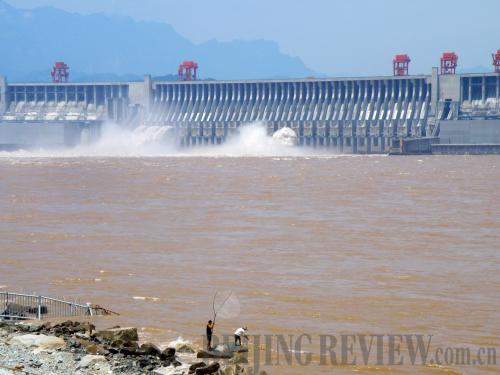|
 |
|
DROUGHT EASE: This file photo shows the Three Gorges Dam in 2010. The reservoir increased water discharge in May to relieve the drought that struck the five provinces along the middle and lower reaches of the Yangtze River (CFP) |
The Three Gorges Dam played an important role in relieving China's drought in central and eastern provinces that had been using increased water discharges from the Dam to irrigate dry farmlands facing the worst drought in the last 60 years in 2011.
A statement from the Office of the State Flood Control and Drought Relief Headquarters said the five provinces—Hubei, Hunan, Anhui, Jiangxi and Jiangsu—which were suffering from their worst drought in 60 years, irrigated 8.63 million mu (575,333 hectares) of farmland, as of the end of May, by using the discharged water.
The Dam, in Hubei Province, had discharged 17 billion cubic meters of water to areas downstream since the beginning of this year. In efforts to alleviate the prolonged drought, the country had discharged more water from the Dam on the Yangtze River. From May 25 to June 10, water flow from the previous 10,000 cubic meters per second was raised to as much as 12,000 cubic meters per second. The reservoir's water level was lowered from 175 meters to below 150 meters.
According to data from the Office of State Flood Control and Drought Relief Headquarters, the five provinces mobilized nearly 6.5 million people to fight the drought. They dug more than 9,600 wells and launched more than 300,000 submersible water pumps to obtain water for irrigation.
"But, all the discharged water can only reach areas along the Jingjiang section of the Yangtze River, so the drought situation in three places in the central part of Hubei—Shishou, Gong'an and Songzi—would be relieved to some degree. But the far lower reaches of the river could only get very limited benefits," said Wang Jingquan, an official of the flood control and drought relief office affiliated to the Yangtze River Water Resources Committee.
The Three Gorges Dam was designed to play a large role in flood control, power generation and waterway transport. But the Office of State Flood Control and Drought Relief Headquarters decided to include drought control as a new task due to the severe drought this year, according to Wang.
In early June the drought was partly eased as rainfall began to increase as the flood season began. On June 10, the Three Gorges Dam reservoir entered flood-prevention mode when it began to store water.
Don't blame the dam
As the drought worsens, some people have begun to blame the dam for causing it.
But there's no evidence showing the connection between the Dam and the drought based on the current observation and data, according to Liu Min, an official with Hubei Meteorological Bureau who has been long observing the impact of the Dam on the climate.
"The drought was a periodic climate phenomenon, which was subject to the impact of general circulation. The observation data before and after the Dam was built show it has little impact on the regional temperature and humidity," Liu said.
"We cannot blame the Dam for all the problems happening in the middle and lower reaches of the Yangtze River. All man-made projects have some impact on nature," Lu Yaoru, a geologist and academician of Chinese Academy of Engineering.
Liu Shukun, a professor at the China Institute of Water Resources and Hydropower Research, also said the cause of this year's drought was the decrease of rainfall instead of the water storage of the Three Gorges Dam.
But discharging water from the Dam's reservoir has some other outcomes, added Liu. The discharged water has helped ease the drought at a cost of the electricity generating. "The Dam is designed to control floods as well as generate power, and now the priority should be given to drought control."
But the Dam does have negative impacts as a statement released by the State Council on May 16 openly acknowledged the side effects of the Dam as saying the Three Gorges Dam needs to address some urgent problems, such as improving the living standards of relocated people, protecting the environment and preventing geological disasters.
Problems emerged at various stages of project planning and construction but could not be solved immediately, and some arose because of increased demands brought on by economic and social development, the statement said.
Urgent action is needed to reduce risks of natural disasters such as landslides and alleviate poverty among the 1.4 million people forced to relocate, the State Council said.
Three Gorges Dam
The Three Gorges Dam, 185 meters (607 ft) high and 2,309 meters (7,575 ft) long, on the Yangtze River, is located in central Hubei Province and is the largest concrete structure in the world. The Dam was constructed from 1994 to 2006. Its hydropower station has 26 turbines with a total installed capacity of 18.2 gigawatts, generating electricity of 84.7 billion kwh annually.
When the water level of the Dam is at its maximum of 175 meters (574 ft) above sea level, the Dam reservoir is on average about 660 km in length and 1.12 km in width. It contains 39.3 billion cubic km of water and has a total surface area of 1,045 square km. | 